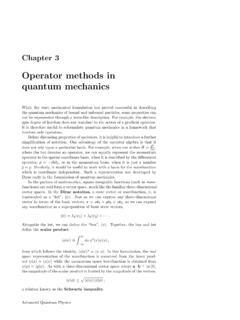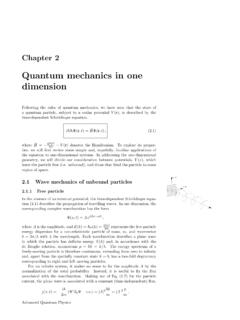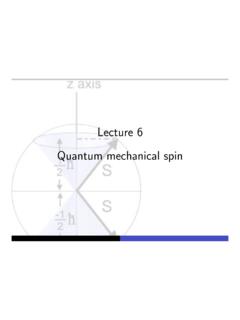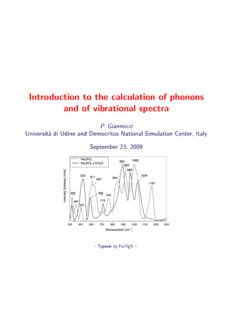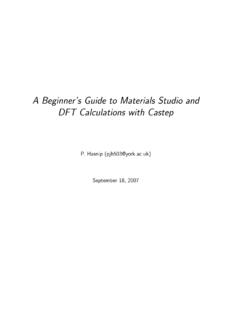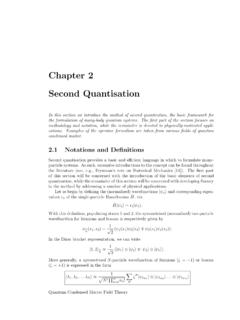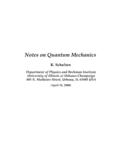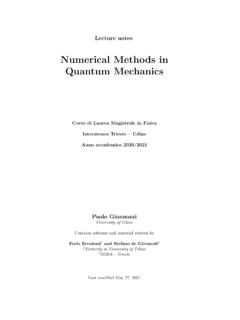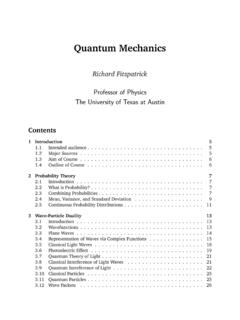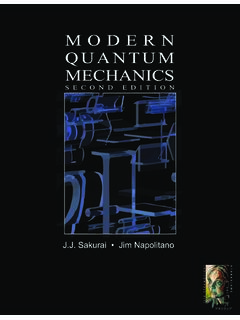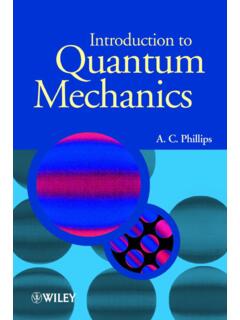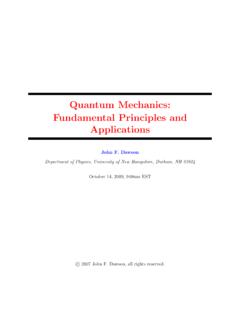Transcription of Quantum mechanics in one dimension - TCM Group
1 Chapter 2 Quantum mechanics in onedimensionFollowing the rules of Quantum mechanics , we have seen that the state ofa Quantum particle, subject to a scalar potentialV(r), is described by thetime-dependent Schr odinger equation,i! t (r,t)= H (r,t),( )where H= !2 22m+V(r) denotes the Hamiltonian. To explore its proper-ties, we will first review some simple and, hopefully, familiar applications ofthe equation to one-dimensional systems. In addressing the one-dimensionalgeometry, we will divide our consideration between potentials,V(x), whichleave the particle free ( unbound), and those that bind the particle to someregion of Wave mechanics of unbound Free particleIn the absence of an external potential, the time-dependent Schr odinger equa-tion ( ) describes the propagation of travelling waves. In one dimension , thecorresponding complex wavefunction has the form (x, t)=Aei(kx t),whereAis the amplitude, andE(k)=!
2 (k)=!2k22mrepresents the free particleenergy dispersion for a non-relativistic particle of mass,m, and wavevectork=2 / with the wavelength. Each wavefunction describes a plane wavein which the particle has definite energyE(k) and, in accordance with thede Broglie relation, momentump=!k=h/ . The energy spectrum of afreely-moving particle is therefore continuous, extending from zero to infinityand, apart from the spatially constant statek= 0, has a two-fold degeneracycorresponding to right and left moving an infinite system, it makes no sense to fix the amplitudeAby thenormalization of the total probability. Instead, it is useful to fix the fluxassociated with the wavefunction. Making use of Eq. ( ) for the particlecurrent, the plane wave is associated with a constant (time-independent) flux,j(x, t)= i!2m( x )=|A|2!km=|A| Quantum WAVE mechanics OF UNBOUND PARTICLES11 For a given value of the fluxj, the amplitude is given, up to an arbitraryconstant phase, byA= mj/!
3 Prepare awave packetwhich is localized to a region of space, we mustsuperpose components of different wave number. In an open system, this maybe achieved using a Fourier expansion. For any function,1 (x), we have theFourier decomposition,2 (x)=1 2 (k)eikxdk ,where the coefficients are defined by the inverse transform, (k)=1 2 (x)e ikxdx .The normalization of (k) follows automatically from the normalization of (x), (k) (k)dk= (x) (x)dx= 1, and both can representprobability amplitudes. Applied to a wavefunction, (x) can be understoodas a wave packet made up of contributions involving definite momentum states,eikx, with amplitude set by the Fourier coefficient (k). The probability for aparticle to be found in a region of widthdxaround some value ofxis given by| (x)|2dx. Similarly, the probability for a particle to have wave numberkin aregion of widthdkaround some value ofkis given by| (k)|2dk.
4 (Rememberthatp=!kso the momentum distribution is very closely related. Here, foreconomy of notation, we work withk.)The Fourier transform of a normalized Gaussian wave packet, (k)=(2 )1/4e (k k0)2, is also a Gaussian (exercise), (x)=(12 )1/4eik0xe x24 .From these representations, we can see that it is possible to represent asingleparticle, localized in real space as a superposition of plane wave states localizedin Fourier space. But note that, while we have achieved our goal of findinglocalized wave packets, this has been at the expense of having some non-zerowidth inxand the Gaussian wave packet, we can straightforwardly obtain the width(as measured by the root mean square RMS) of the probability distribution, x=( (x x )2 )1/2 ( x2 x 2 )1/2= , and k=1 4 . We canagain see that, as we vary the width ink-space, the width inx-space variesto keep the following product constant, x k=12. If we translate from thewavevector into momentump=!
5 K, then p=! kand p x=! we consider the width of the distribution as a measure of the uncertainty ,we will prove in section ( ) that the Gaussian wave packet provides theminimum uncertainty. This result shows that we cannot know the position ofa particle and its momentum at the same time. If we try to localize a particleto a very small region of space, its momentum becomes uncertain. If we try to1 More precisely, we can make such an expansion providing we meet some rather weakconditions of smoothness and differentiability of (x) conditions met naturally by problemswhich derive from physical systems!2 Here we will adopt an ecomony of notation using the same symbol to denote thewavefunction and its Fourier coefficients. Their identity will be disclosed by their argumentand Quantum WAVE mechanics OF UNBOUND PARTICLES12make a particle with a definite momentum, its probability distribution spreadsout over this introduction, we now turn to consider the interaction of a par-ticle with a non-uniform potential background.
6 For non-confining potentials,such systems fall into the class ofscattering problems: For a beam of par-ticles incident on a non-uniform potential, what fraction of the particles aretransmitted and what fraction are reflected? In the one-dimensional system,the classical counterpart of this problem is trivial: For particle energies whichexceed the maximum potential, all particles are eventually transmitted, whilefor energies which are lower, all particles are reflected. In Quantum mechan-ics, the situation is richer: For a generic potential of finite extent and height,some particles are always reflected and some are always transmitted. Later,in chapter 14, we will consider the general problem of scattering from a lo-calized potential in arbitrary dimension . But for now, we will focus on theone-dimensional system, where many of the key concepts can be Potential stepAs we have seen, for a time-independent potential, the wavefunction can befactorized as (x, t)=e iEt/!
7 (x), where (x) is obtained from the stationaryform of the Schr odinger equation,[ !2 2x2m+V(x)] (x)=E (x),andEdenotes the energy of the particle. As| (x, t)|2represents a probablilitydensity, it must be everywhere finite. As a result, we can deduce that thewavefunction, (x), is also finite. Moreover, sinceEandV(x) are presumedfinite, so must be 2x (x). The latter condition implies that'both (x) and x (x) must be continuous functions ofx, even ifVhasa then the influence of a potential step (see figure) on the prop-agation of a beam of particles. Specifically, let us assume that a beam ofparticles with kinetic energy,E, moving from left to right are incident upon apotential step of heightV0at positionx= 0. If the beam has unit amplitude,the reflected and transmitted (complex) amplitudes are set byrandt. Thecorresponding wavefunction is given by <(x)=eik<x+re ik<xx<0 >(x)=teik>xx>0wherek<= 2mE!
8 2andk>= 2m(E V0)!2. Applying the continuity conditionson and x at the step (x= 0), one obtains the relations 1 +r=tandik<(1 r)=ik>tleading to the reflection and transmission amplitudes,r=k< k>k<+k>,t=2k<k<+k>.The reflectivity,R, and transmittivity,T, are defined by the ratios,R=reflected fluxincident flux,T=transmitted fluxincident Quantum WAVE mechanics OF UNBOUND PARTICLES13 With the incident, reflected, and transmitted fluxes given by|A|2!k<m,|Ar|2!k<m,and|At|2!k>mrespectively, one obtainsR= k< k>k<+k> 2=|r|2,T= 2k<k<+k> 2k>k<=|t|2k>k<=4k<k>(k<+k>) these results one can confirm that the total flux is, as expected, conservedin the scattering process, +T= 1.' V0remains positive, show that the beam is able to prop-agate across the potential step (see figure). Show that the fraction of the beam thatis reflected depends on the relative height of the step while the phase depends on thesign ofV0.
9 In particular, show that forV0>0, the reflected beam remains in phasewith the incident beam, while forV0<0 it is reversed. Finally, whenE V0<0,show that the beam is unable to propagate to the right (R= 1). Instead show thatthere is an evanescent decay of the wavefunction into the barrier region with a decaylength set by 2 !2/2m(V0 E). IfV0 , show that the system forms a standingwave Potential barrierHaving dealt with the potential step, we now turn to consider the problemof a beam of particles incident upon a square potential barrier of heightV0(presumed positive for now) and widtha. As mentioned above, this geometryis particularly important as it includes the simplest example of a scatteringphenomenon in which a beam of particles is deflected by a local , this one-dimensional geometry also provides a platform to explorea phenomenon peculiar to Quantum mechanics Quantum tunneling. Forthese reasons, we will treat this problem fully and with some the barrier is localized to a region of sizea, the incident and trans-mitted wavefunctions have the same functional form,eik1x, wherek1= 2mE!
10 2,and differ only in their complex amplitude, after the encounter with thebarrier, the transmitted wavefunction undergoes only a change of amplitude(some particles are reflected from the barrier, even when the energy of theincident beam,E, is in excess ofV0) and a phase shift. To deterimine the rel-ative change in amplitude and phase, we can parameterise the wavefunctionas 1(x)=eik1x+re ik1xx 0 2(x)=Aeik2x+Be ik2x0 x a 3(x)=teik1xa xwherek2= 2m(E V0)!2. Here, as with the step,rdenotes the reflected ampli-tude andtthe the continuity conditions on the wavefunction, , and its deriva-tive, x , at the barrier interfaces atx= 0 andx=a, one obtains{1+r=A+BAeik2a+Be ik2a=teik1a,{k1(1 r)=k2(A B)k2(Aeik2a Be ik2a)= , these four equations specify the four unknowns,r,t, , one obtains (exercise)t=2k1k2e ik1a2k1k2cos(k2a) i(k21+k22) sin(k2a),Advanced Quantum WAVE mechanics OF UNBOUND PARTICLES14translating to a transmissivity ofT=|t|2=11+14(k1k2 k2k1)2sin2(k2a),and the reflectivity,R=1 T.}}
